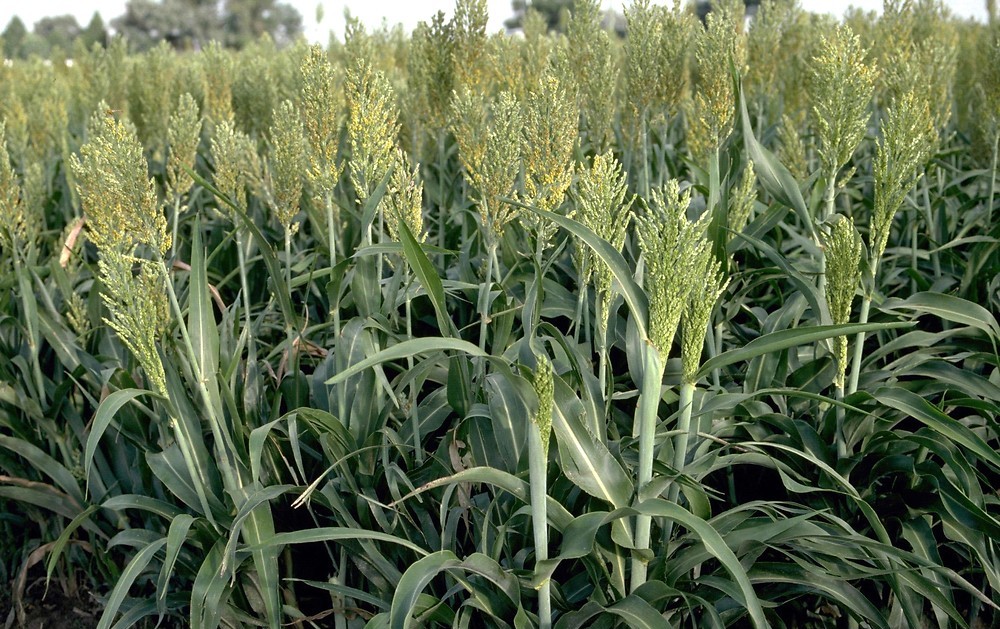Sorghum bicolor

|
|
Sorghum bicolor Common Names: Sorghum, millet, guinea corn Scientific
Classification Kingdom: Plantae Clade: Tracheophytes Clade: Angiosperms Order: Poales Family: Poaceae Genus: Sorghum Species: S. bicolor Binomial Name: Sorghum bicolor (L.) Moench Synonyms: Sorghum vulgare Pers., Sorghum saccharatum Host, Sorghum nervosum Chiov. Morphological Description Sorghum bicolor, widely recognized as sorghum or guinea corn, is a robust annual
or perennial grass capable of growing to heights of 1–4 meters, depending on
cultivar and environmental conditions (Kew Science, 2024). The plant features
erect, fibrous stems that are solid or pithy, often with a waxy coating, and
can reach diameters of 2–5 cm. Its leaves are broad, lanceolate, and alternate,
measuring 30–100 cm long and 2–10 cm wide, with a prominent midrib and a
slightly wavy margin (Purseglove, 1972). The inflorescence is a large, bushy
panicle, 10–60 cm long, bearing numerous spikelets that produce small, starchy
grains, typically 2–4 mm in diameter. Grain color varies widely—white, yellow,
red, or brown—reflecting its genetic diversity (Dillon et al., 2007). Sorghum’s
deep, extensive root system enhances its drought tolerance, making it a staple
in arid regions. Distribution and Habitat Originating in
northeastern Africa around 8,000 years ago, Sorghum bicolor is now cultivated globally across tropical
and subtropical regions, including Africa, Asia (e.g., India, China), the
Americas (e.g., USA, Brazil), and parts of Europe (Dillon et al., 2007; Kew
Science, 2024). It thrives in warm climates with temperatures of 25–35°C and
annual rainfall of 400–800 mm, though it can survive with as little as 300 mm
due to its drought resistance (Purseglove, 1972). The plant prefers
well-drained, fertile soils with a pH of 5.5–7.5 but adapts to sandy, loamy, or
clay soils, often at altitudes up to 1,800 meters (FAO, 2024). Its resilience
makes it a vital crop in semi-arid zones, particularly in the Sahel and Horn of
Africa. Ethnopharmacology Sorghum bicolor has a long history in traditional medicine across Africa and
Asia, attributed to its rich phytochemical content, including phenolic
compounds, tannins, and flavonoids (Awika & Rooney, 2004). Below are key
ethnopharmacological uses supported by research: · Antioxidant and Anti-inflammatory: In Nigeria, sorghum grain decoctions treat
inflammation and oxidative stress-related conditions. Studies show that
phenolic extracts from red sorghum inhibit lipid peroxidation by 70% in vitro
and reduce pro-inflammatory cytokines (e.g., TNF-α) in animal models,
validating its traditional use (Taylor et al., 2014). · Digestive Health: In Ethiopia, fermented sorghum porridge
(injera) is used for diarrhea and stomach ailments. Its high dietary fiber
(6–12 g/100 g) and prebiotic oligosaccharides promote gut microbiota health,
supported by clinical trials showing improved bowel regularity (Dicko et al.,
2006). · Antimicrobial Effects: In Sudan, sorghum husk infusions treat
infections. Studies have
demonstrated that phenolic extracts from sorghum can inhibit the growth of
various pathogenic bacteria, including Staphylococcus aureus, Enterococcus faecalis,
Campylobacter jejuni, and Campylobacter coli. Additionally, polyphenol extracts
from sweet sorghum stalks have shown antibacterial activity against Escherichia
coli, Listeria spp., and Salmonella spp., likely by disrupting bacterial
membrane integrity (Schnur et al., 2021; and Chen 2022 ). · Diabetes Management: In India, sorghum grains are consumed to
regulate blood sugar. Research confirms that its low glycemic index (55–65) and
polyphenolic compounds reduce postprandial glucose by 20–30% in diabetic subjects
(Prasad et al., 2015). These properties stem
from its nutrient profile, including vitamins (e.g., B3, 3–4 mg/100 g) and
minerals (e.g., iron, 3–5 mg/100 g), enhancing its role in disease prevention
(Awika & Rooney, 2004). ⚠ Toxicity Profile: Sorghum bicolor contains cyanogenic glycosides (e.g.,
dhurrin), particularly in young shoots and stressed plants, which can hydrolyze
into hydrogen cyanide (HCN) at levels of 50–500 mg/kg dry weight (FAO, 2024).
Consumption of improperly processed sorghum may cause cyanide poisoning, with
symptoms including dizziness, nausea, and, in severe cases, respiratory
failure. Processing (e.g., soaking, boiling) reduces HCN by 70–90%, making
grains safe for human and animal use (Purseglove, 1972). Grazing livestock on drought-stressed
sorghum can lead to fatalities if HCN exceeds 200 ppm in forage (Dillon et al.,
2007). Additional Uses · Food and Feed: Grains are used in porridges, breads (e.g., injera), and
beer, while stalks serve as fodder, yielding 10–20 tons/ha of dry matter (FAO,
2024). · Biofuel and Industry: Sorghum’s high sugar content (10–15% in
sweet varieties) supports ethanol production (up to 400 L/ton), and its stalks
are used for biodegradable plastics (Dillon et al., 2007). · Ecological Resilience: Its C4 photosynthesis and drought
tolerance make it a key crop for climate adaptation, supporting food security
in over 30 million hectares globally (Taylor et al., 2014). References
External Links More Pictures |
|
| Compounds of Sorghum bicolor | |
| References |